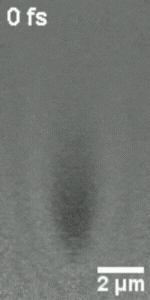Watch Energy In Motion With Milan Delor
The physical chemist at Columbia and recent recipient of a Beckman Young Investigator Award builds instruments to image quantum particles as they move.

Energy is all around us. Electrons flowing through electrical circuits might be the most familiar form, but there are other quantum particles to consider, like packets of light called photons and tiny heat-emitting vibrations called phonons. The ability to harness these particles powers our daily lives and transmits information around the world, but our devices could be better. For Milan Delor, who wants to develop new energy and information technologies, seeing is the first step.
Delor is a physical chemist though, he admitted, don’t ask him to draw complex chemical structures. His specialty is imaging and controlling energy as it flows through different materials, which his lab does with custom-built optical microscopes.
“We can image electron flow, exciton flow, heat flow, light flow, spin flow, and, most important, the interactions between these different types of energy and how that impacts material properties,” Delor said. “Imaging material function with high spatiotemporal resolution and under different stimuli really lets you understand it, which in turn helps you control it.” The ability to control energy transport could one day yield materials for solar panels and photocatalysts that more efficiently harvest light, or for wave-based electronics that could drastically speed up computers.
"We are moving beyond single particles. Everything is dynamic, almost everything interacts, and these interactions lead to the most fascinating material properties."
The Delor lab’s microscopes are built around a simple concept, he explained: energy in a material will change either its color or its reflectivity, which can be observed with optical microscopes. The tricky part is the speed. “Particles in materials usually move and interact very quickly, so your microscope needs to be extremely fast,” Delor said. “His lab’s fastest microscopes use femtosecond lasers—that’s one quadrillionth of a second—to take snapshots that can be combined into movies depicting energy flow. They can also “see” down to just a few particles in a sample.
As a member of Columbia’s National Science Foundation-funded Materials Research and Science Engineering Center on Precision Assembled Quantum Materials, the Delor lab has no shortage of interesting new options to place under their microscopes. “We work with amazing scientists who make materials that no one has ever looked at before. We get to be the first, which is really motivating to me and my students,” Delor said.
Since joining Columbia in fall 2019, the Delor lab has grown to include a postdoc, six graduate students, one undergrad, and a high schooler. Delor ensures that nothing is a black box. “Our instruments are constantly changing, and I insist that everyone is comfortable building, rebuilding, and modifying the microscopes we use,” he said.
Some instruments are built and destroyed within a few months; it can take years to develop one that works. Those that have been tried and tested are promoted to the workhorse table, where they are put to use imaging the latest 2D materials, superatomic structures, soft polymers, and more that Delor’s lab members and collaborators have created.

The lab’s workhorse microscopes can record a dataset within about half an hour. That means the lab can move relatively quickly through different materials in the hunt for something that looks interesting. Delor is most intrigued when multiple particles combine. For example, they’ve observed electrons “surfing” on sound waves, which raises the possibility of using sound to control electrical currents. Other potentially interesting combinations include electrons and heat and light-matter particles called polaritons.
“As a field, we are moving beyond single particles. Everything is dynamic, almost everything interacts, and these interactions lead to the most fascinating material properties both for fundamental research and applications,” Delor said.
One big challenge is size. Electrons, for example, are 500 times smaller than the photons used in optical microscopes, so researchers need to get creative with how they apply light to their samples to detect processes occurring on the tiny length scales of quantum interactions. With a $600,000, four-year Young Investigator Award from the Arnold and Mabel Beckman Foundation, Delor plans to develop a multimodal instrument that leverages the quantum properties of light to image and manipulate the building blocks of chemical and material function one particle at a time. “That’s a huge frontier in imaging science,” he said.
